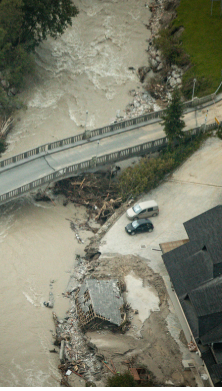At-a-glance data identifying the top causes of liability loss for businesses and breakdown of insurance claims by average and median payments, region and selected countries.
Top causes of liability loss according to value of claims**

* Up to September 13, 2016.
** Top causes of liability loss expressed as a % of value of all claims analyzed. Other causes of loss account for 14% of the value of all claims analyzed.
Causes of loss detailed above include awards for cases of bodily injury/death. Analysis does not include financial lines claims.
100,073 claims with a total value of approximately €8.85bn were analyzed between 2011 and 2016.
Top causes of liability loss: average and median insurance claims values

The average claim value can be impacted by "very large events" - which are significantly different relative to "normal" claims activity associated with the cause of loss. On the other hand liability losses also incorporate a huge number of small claims, which can reduce the average value significantly. e.g. the average liability claim for a defective product/work incident is €263,903.
The median claim value is the value which separates the higher half of all claims payments relating to the cause of loss from the lower half. e.g. the median claim value for a defective product/work incident is €4,114.
The median claim value is the value which separates the higher half of all claims payments relating to the cause of loss from the lower half. e.g. the median claim value for a defective product/work incident is €4,114.
Top causes of liability loss according to number of claims received

Impact of collision/crash accounts for almost a third of liability claims by number.
Top causes of liability loss per region (by value of claims)



Human error incidents are the top cause of liability loss in the Africa and Australia & New Zealand regions, according to value of claims. While this loss category includes the impact of everyday employee errors, payments are significantly higher where incidents result in major losses such as aviation and shipping incidents or serious employee injury, for example.
Collison/crash incidents are the top cause of liability loss in the Americas and Asia regions, accounting for almost half of claims value in Asia (48%) and over a third of claims value in the Americas (35%), driven by automotive and aviation sector loss activity in particular.
Defective product/work incidents, including costs associated with product recalls, are the main liability loss driver in Europe, accounting for over 40% of total claims value, with the automotive and engineering sectors being particularly impacted.
Collison/crash incidents are the top cause of liability loss in the Americas and Asia regions, accounting for almost half of claims value in Asia (48%) and over a third of claims value in the Americas (35%), driven by automotive and aviation sector loss activity in particular.
Defective product/work incidents, including costs associated with product recalls, are the main liability loss driver in Europe, accounting for over 40% of total claims value, with the automotive and engineering sectors being particularly impacted.
How the numbers stack up: distribution of liability claims payments

Breakdown of liability losses per region

The Americas region, driven by the US, continues to be the largest liability market in terms of number of claims generated, accounting for over half of all claims analyzed. Today, liability loss activity is largely driven by the US and Europe. However, claims in Asia and Latin America in particular are likely to increase further in future.
Top causes of liability loss per line of business (by value of claims)

Unsurprisingly collision/crash is the top cause of liability loss, accounting for over half of the value of claims (53%). However, such incidents do not just include major commercial aviation incidents, they also incorporate such loss activity in the general aviation sector and ground handling incidents as well. Accidental nature/damage, natural hazards, slips/falls and impact of falling objects and defective product/work are the other leading causes of liability loss in the sector.

Impact of defective product/work incidents is the top cause of liability loss in the sector, followed by damage caused to equipment and premises by water, fire and smoke. Together, these two top causes of loss account for over two thirds of claims according to value. Human error, natural hazards and vandalism/terrorism are the other top causes of loss, with human error generating the highest number of claims for insurers.

Human error has long been regarded as a major cause of incidents in the shipping sector. It is estimated that between 75% to 96% of marine accidents can be attributed to human error[1]. Such incidents also rank as the top cause of liability loss, driven by the high costs that can be associated with the impact of a major event, such as wreck removal (which is becoming more complex and expensive, primarily due to larger ships and environmental concerns), passenger and crew liabilities and pollution and litigation costs, for example. The Costa Concordia and MV Rena groundings are two well-documented incidents caused by human error[2] which have resulted in significant liability losses over the past five years.
Crew negligence and inadequate vessel maintenance are potentially increasing areas of risk in the current tough economic shipping environment, particularly if shipowners opt to recruit crew with less experience and fewer qualifications/training in order to save money or choose to stretch maintenance work to the longest possible intervals. Negligence/poor maintenance is already one of the top causes of liability loss in the sector, so vigorous inspection and maintenance regimes are crucial. Obtaining buy-in from all levels of the workforce is important in creating a transparent and effective mechanism for reporting accidents and other potential areas of concern, learning lessons and, ultimately, implementing preventative measures as a result.
Other major causes of liability loss include: crew injuries, subsequent loss of income and expenses such as medical costs; damages to cargo while engaged in handling activities; leaks at port terminals resulting in environmental damages; vessel collisions leading to pollution spills; and accidental damage to key infrastructure, such as natural gas pipes, for example.
Crew negligence and inadequate vessel maintenance are potentially increasing areas of risk in the current tough economic shipping environment, particularly if shipowners opt to recruit crew with less experience and fewer qualifications/training in order to save money or choose to stretch maintenance work to the longest possible intervals. Negligence/poor maintenance is already one of the top causes of liability loss in the sector, so vigorous inspection and maintenance regimes are crucial. Obtaining buy-in from all levels of the workforce is important in creating a transparent and effective mechanism for reporting accidents and other potential areas of concern, learning lessons and, ultimately, implementing preventative measures as a result.
Other major causes of liability loss include: crew injuries, subsequent loss of income and expenses such as medical costs; damages to cargo while engaged in handling activities; leaks at port terminals resulting in environmental damages; vessel collisions leading to pollution spills; and accidental damage to key infrastructure, such as natural gas pipes, for example.

The mid-corporate line of business incorporates small to mid-sized businesses across different industries. Impact of collision/crash incidents is the top cause of liability loss according to both value of claims and number of claims received, reflecting the large number of automotive incidents. Slips/falls and impact of falling objects accounts for over a third of claims according to value and around a quarter of all claims according to number.
Food-related claims, including poisoning incidents, spills and accidents, are a major cause of liability loss in this line of business, reflecting the fact that it incorporates the hospitality sector.
Food-related claims, including poisoning incidents, spills and accidents, are a major cause of liability loss in this line of business, reflecting the fact that it incorporates the hospitality sector.
Top causes of liability loss per selected countries (by value of claims)





SOURCES
1. Safety & Shipping 1912-2012 From Titanic to Costa Concordia, Allianz Global Corporate & Specialty
2. Cruise ship owners admit ‘human error, BBC, January 16, 2012. Two jailed over New Zealand Rena ship disaster, BBC, May 25, 2012
Newsletter
Keep up to date on all news and insights from Allianz Commercial















